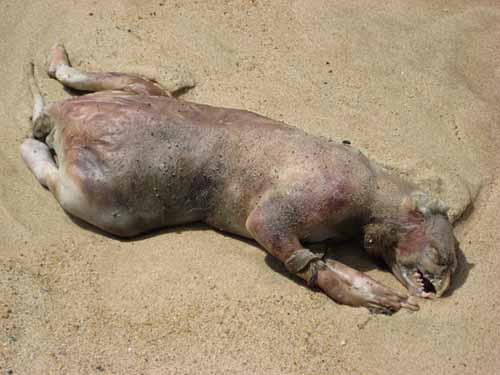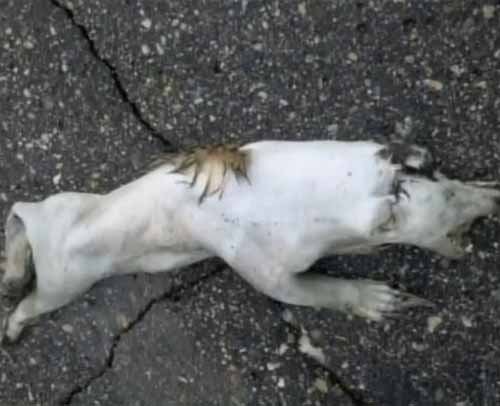

The "Montauk Monster" was an unidentified creature that washed ashore dead, on a beach near the business district of Montauk, New York in July 2008. The identity of the creature, and the veracity of stories surrounding it, have been the subject of unresolved controversy and speculation. It is unknown what happened to the carcass. Although the creature's body was never reported as recovered or physically examined, palaeozoologist Darren Naish studied the photograph and concluded from visible dentition and the front paws that the creature was a raccoon, with its odd appearance merely a byproduct of decomposition and water action removing most of the animal's hair and some of its flesh.
The story began on July 23, 2008 with an article in a local newspaper, The Independent. Jenna Hewitt, 26, of Montauk, and three friends said they found the creature on July 12 at the Ditch Plains beach, two miles east of the district. The beach is a popular surfing spot at Rheinstein Estate Park owned by the town of East Hampton. Jenna Hewitt was quoted:
We were looking for a place to sit when we saw some people looking at something... We didn't know what it was... We joked that maybe it was something from Plum Island.
Her color photograph of the creature ran in black and white under the headline "The Hound of Bonacville" (a take-off on the name Bonackers, which refers to the natives of East Hampton, and The Hound of the Baskervilles which is a book in the Sherlock Holmes series by Sir Arthur Conan Doyle). The light-hearted article speculated that the creature might be a turtle or some mutant experiment from the Plum Island Animal Disease Center before noting that Larry Penny, the East Hampton Natural Resources Director, had concluded it was a raccoon with its upper jaw missing. There were rumors that the carcass had been taken away from the site.
A local newspaper quoted an unidentified woman, who claimed that the animal was only the size of a cat, and that it had decomposed to a skeleton by the time of the press coverage. She would not identify its location for inspection. Hewitt claimed that "a guy took it and put it in the woods in his backyard", but would not say who or where. Her father denied that his daughter was keeping the body's location a secret.
Hewitt and her friends were interviewed on Plum-TV, a local Public-access television show. Alanna Navitski, an employee of Evolutionary Media Group in Los Angeles, California, passed a photo of the creature to Anna Holmes at Jezebel, claiming that a friend's sister saw the monster in Montauk. Holmes then passed it along to fellow Gawker Media website Gawker.com which gave it wide attention on July 29 under the headline "Dead Monster Washes Ashore in Montauk".
Cryptozoologist Loren Coleman at Cryptomundo first coined the name the "Montauk Monster" on July 29, 2008. The moniker was disseminated globally on the Internet in the following days. Photographs were widely circulated via email and weblogs, and the national media picked up on it raising speculation about the creature. The potential urban legend stature of the Montauk Monster was noted by Snopes.
In May 2009, the National Post reported that the owner of montauk-monster.com claimed to have found another "incarnation" of the Montauk Monster.
The monster has appeared on Jesse Ventura's Conspiracy Theory and the History Channel series Ancient Aliens. In 2009, the show Monster Quest examined the Montauk Monsters remains and concluded it was the remains of a boxer dog, due to similar body structures and skull shape. Montauk Monster

Mystery Minnesota Monster Sparks Speculation
Discovery - August 8, 2011
A strange animal found on a Douglas County, Minnesota, road has people talking monsters. The Star Tribune offered this description of the animal that Lacey Ilse found alongside a road in Alexandria: ghostly white and hairless, its neck bloated out of proportion with the rest of its limp body. Ilse said it looked half human, and told her friends about it.
Soon photos of the little beastie flew around the Internet and became a minor Facebook sensation. The Montreal Gazette claimed a few days ago that scientists are baffled, though the public has been happy to offer their theories.
Speculations about what the creature may be include a dog, a badger, a wolf, raccoon, and even a top-secret government experiment. Predictably, some suggested that the monster is instead the chupacabra, the Hispanic vampire beast. In fact the animal looks nothing like the original chupacabra (which was revealed earlier this year to have come from a science fiction film), nor does it resemble the chupacabras found mainly in Texas that have been shown through DNA analysis to be dogs and coyotes. Furthermore, it was not seen (nor even suspected of) sucking blood.
So what is it?
Biologists have several ways of identifying animals. One of the best is through simply comparing the animal's weight, size, and other characteristics to those of known animals. There’s an even more specialized field of study called taphonomy that deals specifically with dead and decaying animals. Since many animals are found in early states of decomposition, it's important to understand what happens to creatures after they die. For example, hair falls out, tissue shrinks away from teeth and nails, and so on; all these can contribute to a mysterious or otherworldly appearance.
Why would it be ghostly white and hairless? Because it's been dead a while and the blood has pooled or coagulated, and most of the hair has fallen out from decay. Why would the back part look so misshapen, as several people noticed? Probably because it had been run over by a car or truck, having been found in the middle of the road.
There's another, less obvious reason to believe that the beast is merely a common animal instead of a new creature or unknown monster: only one of them has been found. For the same reason that there must be thousands, or tens of thousands, of Bigfoot in North America to maintain a sufficiently large breeding population, there should be thousands of these critters around if they are a new species.
A few weeks ago a Texas boy shot and killed an animal thinking it might be a chupacabra, though it's likely a coyote or dog. In cases like this it's important to realize that just because we see something unusual doesn't mean it actually is anything unknown or unusual. Put another way, if we see a three-legged dog by the side of the road we don't assume that it must be a previously unknown breed of three-legged dogs that science has not discovered. Instead we logically assume that the dog likely lost its leg through an accident or birth defect. Yet when it comes to other known animals with a strange appearance, people often reach for extraordinary explanations instead of logical ones.